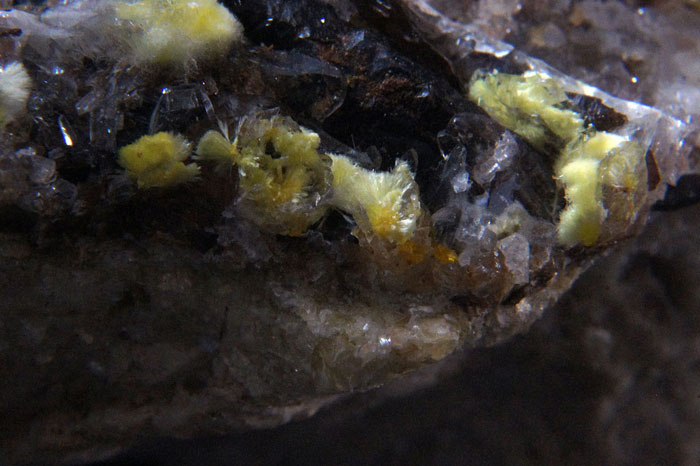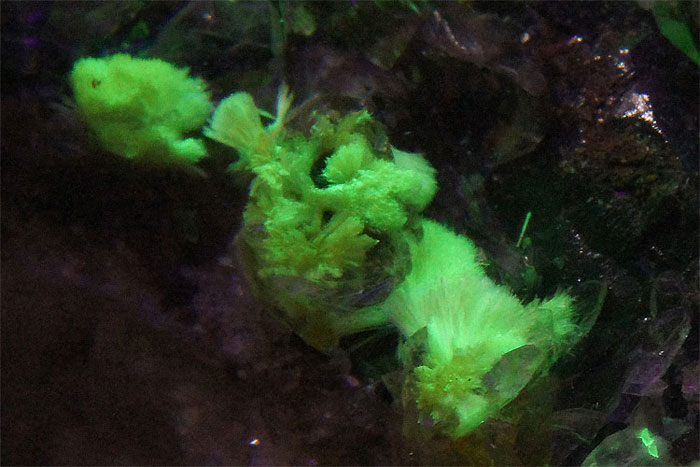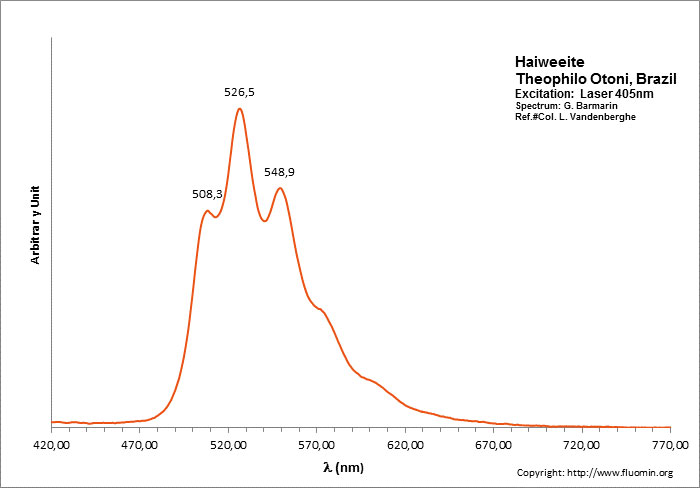Database of luminescent minerals
HAIWEEITE
Chemical formula: Ca[(UO2)2Si5O12(OH)2] 3H2O
Family: Silicates
Status: IMA-GP
Display mineral: NON
Associated names (luminescent varieties, discredited names, synonyms, etc.): ranquilite, gastunite,
Luminescence:
Longwave UV (365nm) colors: |
Green , | ||
Intensity LW:Weak | |||
Shortwave UV (254nm) colors: |
Green , | ||
Intensity SW:Weak | |||
Daylight picture

Haiweeite de Teofilo Otoni, Minas Gerais, Br�sil;
Daylight
Photo and Copyright: G. Barmarin
Col.: L. Vandenberghe
Shortwave (254nm) picture

Haiweeite de Teofilo Otoni, Minas Gerais, Br�sil;
OC (254 nm).
Photo and Copyright: G. Barmarin
Col.: L. Vandenberghe
Pictures Galery:



 ...
...  Go to the galery (12 pictures)
Go to the galery (12 pictures)
Do you have a photo of this mineral you would like to see in the gallery? Contact us!
Phosphorescence (in the common sense of the term) observable with the naked eye:
No phosphorescence visible to the naked eye under any type of UV
Activator(s) and spectrum:
Activator(s): (UO2)2+ (ion Uranyle) intrinsèque ,
Peaks in the spectrum (nm):
(UO2)2+ : 508, 526, 549nm

HAIWEETE, Excitation: laser 405nm. Col. L. Vandenberghe; Spectre: G. Barmarin
Best localities for fluorescence (*):
- Haiwee Reservoir, Coso Mountains, California, USA;
- Teofilo Otoni, Minas Gerais, Brésil;
(*)The data are not exhaustive and are limited to a few remarkable localities for fluorescence
Bibliographic reference for luminescence:
- The Henkel Glossary of Fluorescent Minerals, Dr. Gerhard Henkel, Published by the FMS, 1989 ,
- Fluorescence: Gems and Minerals Under Ultraviolet Light, Manuel Robbins, 1994, Geoscience Press, ISBN 0-945005-13-X ,
- Uranium minerals Website: http://www.uraniumminerals.com ,
- Introduction to radioactive minerals, Robert Lauf, Schiffer Publishing, 2008, ISBN 978-0-7643-2912-8 ,
Mineralogical reference on the Internet:
 http://www.mindat.org/show.php?name=Haiweeite
http://www.mindat.org/show.php?name=Haiweeite
 http://webmineral.com/data/Haiweeite.shtml
http://webmineral.com/data/Haiweeite.shtml
Internet Search:
 Image search on 'Google Images'
Image search on 'Google Images'
 Search for documents in all languages on Google
Search for documents in all languages on Google
A request providing no result means only that no such reference exists in the database, but it does not mean that what you are looking for does not exist, just not to our knowledge. If you think you have found an error or omission, please let us know via the contact page being sure to cite the source of information.
